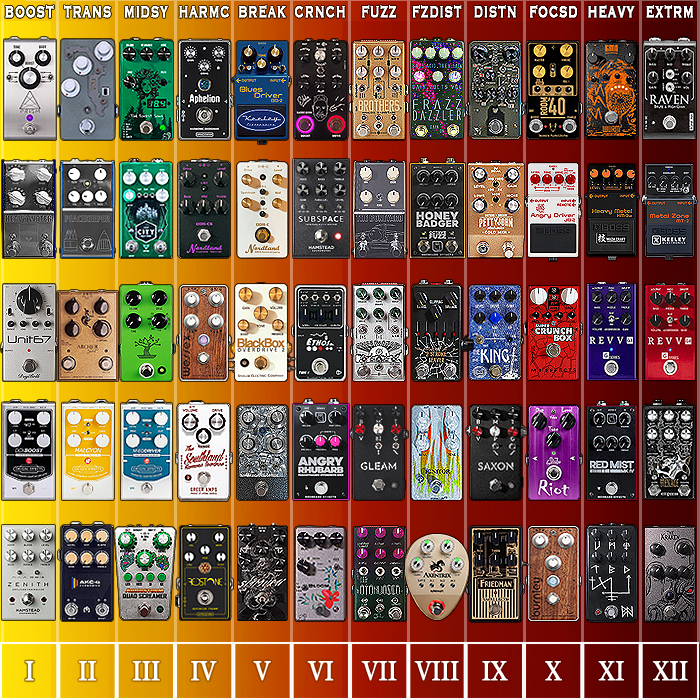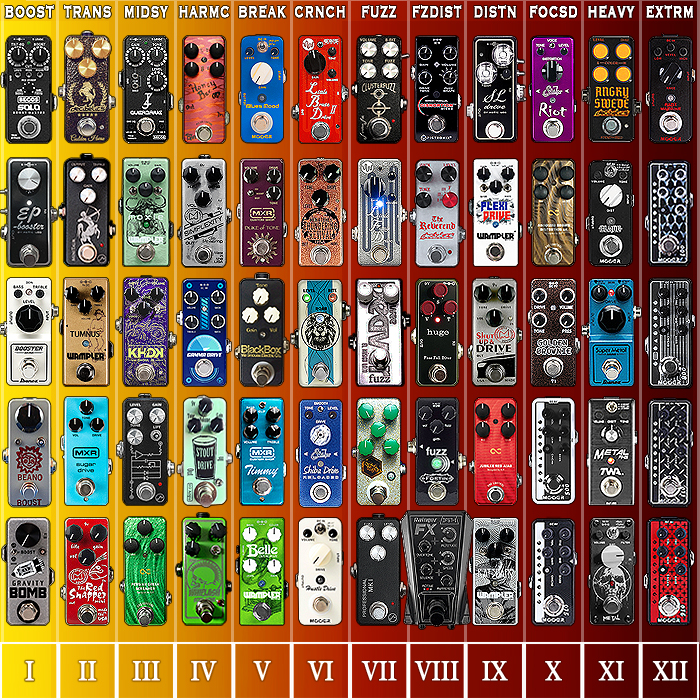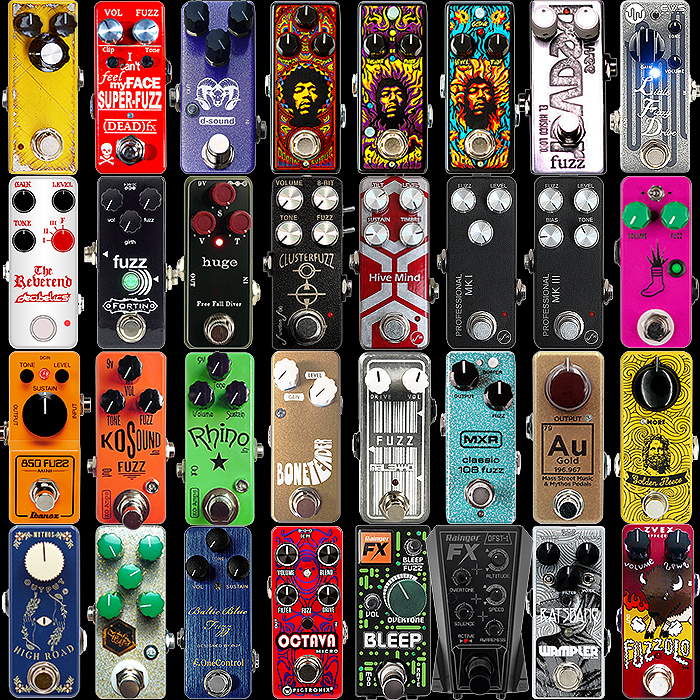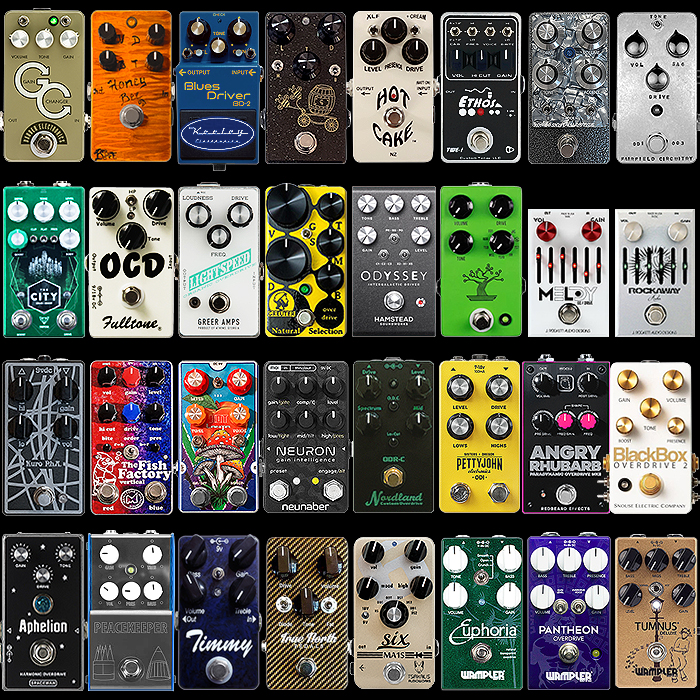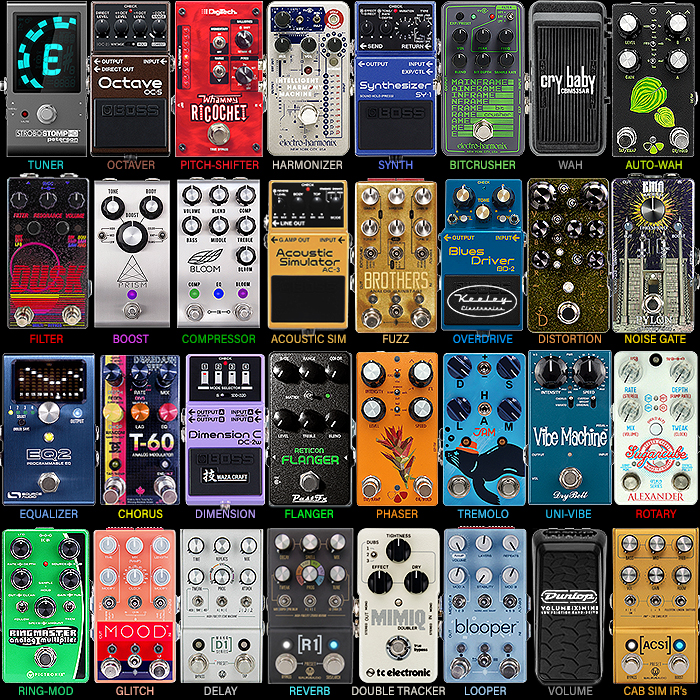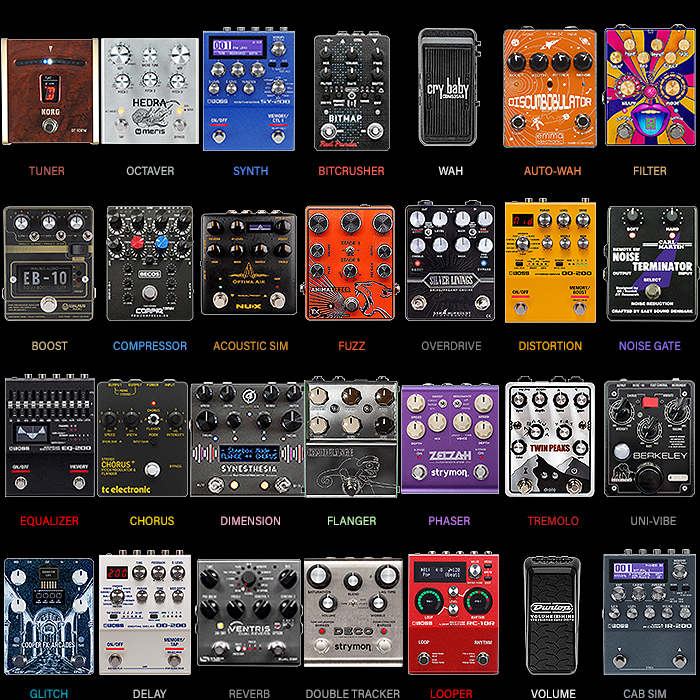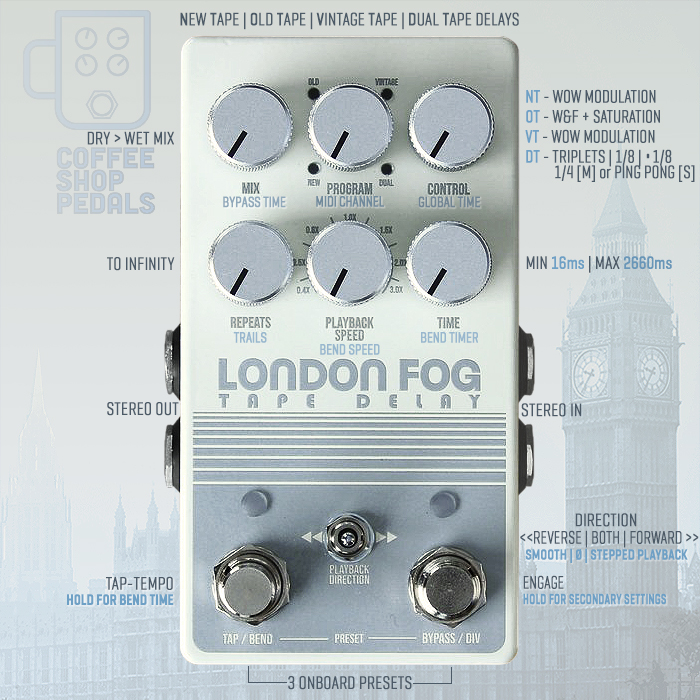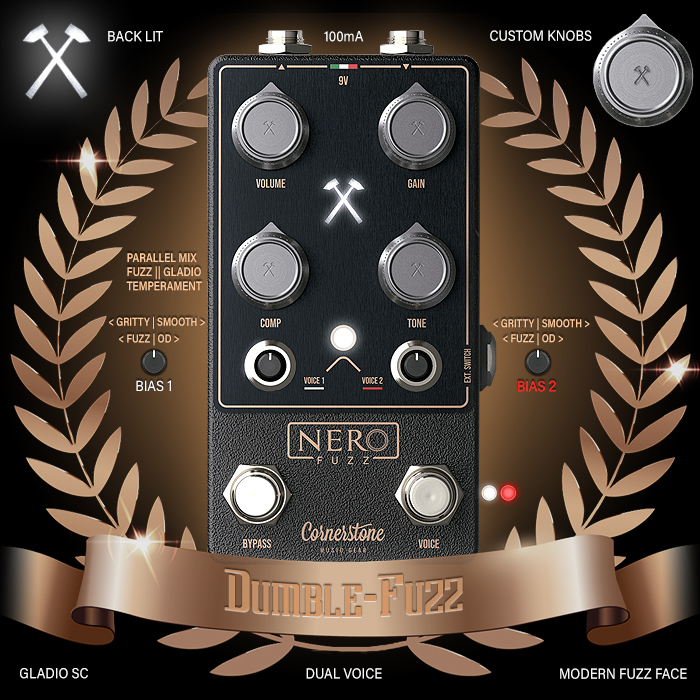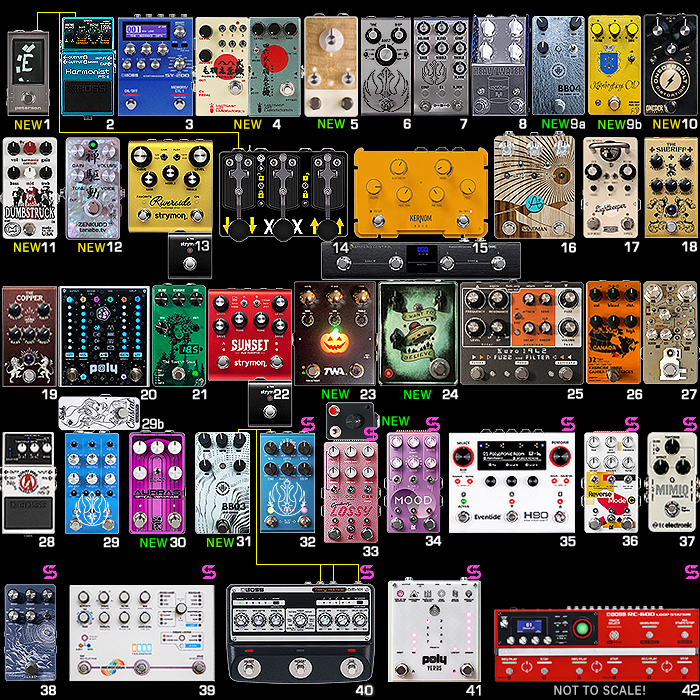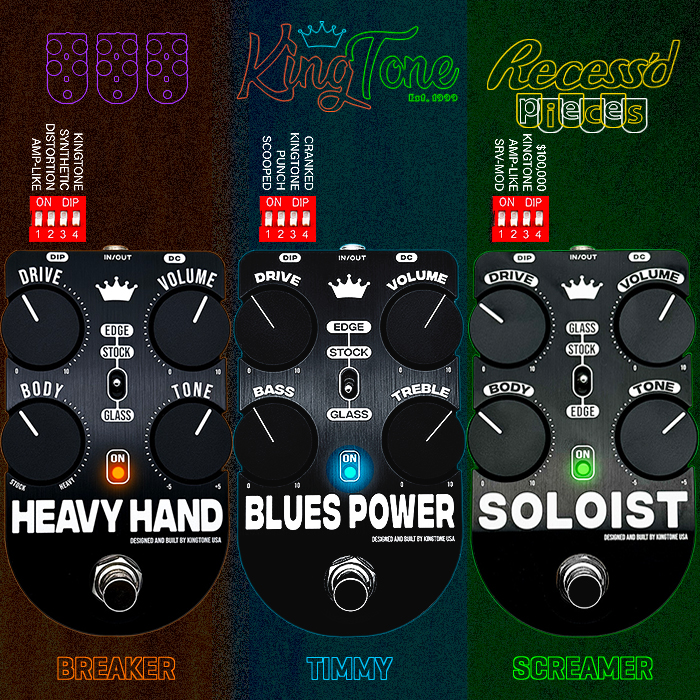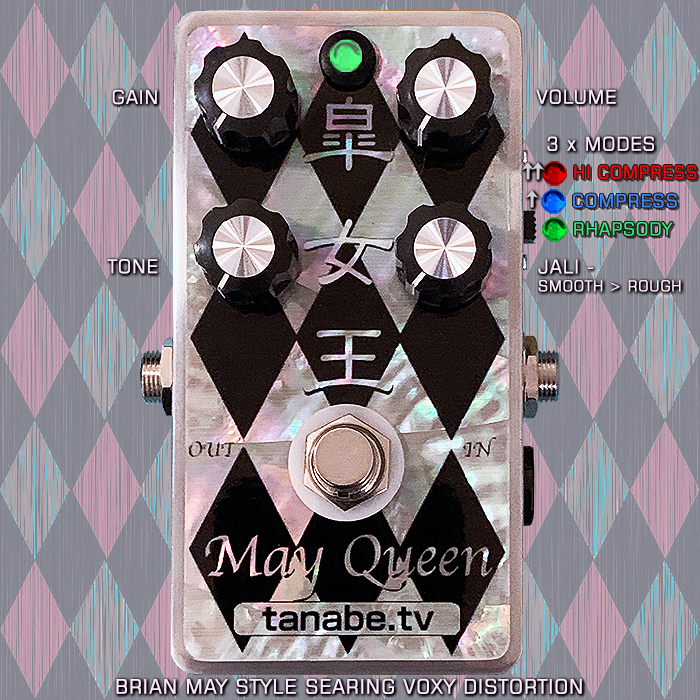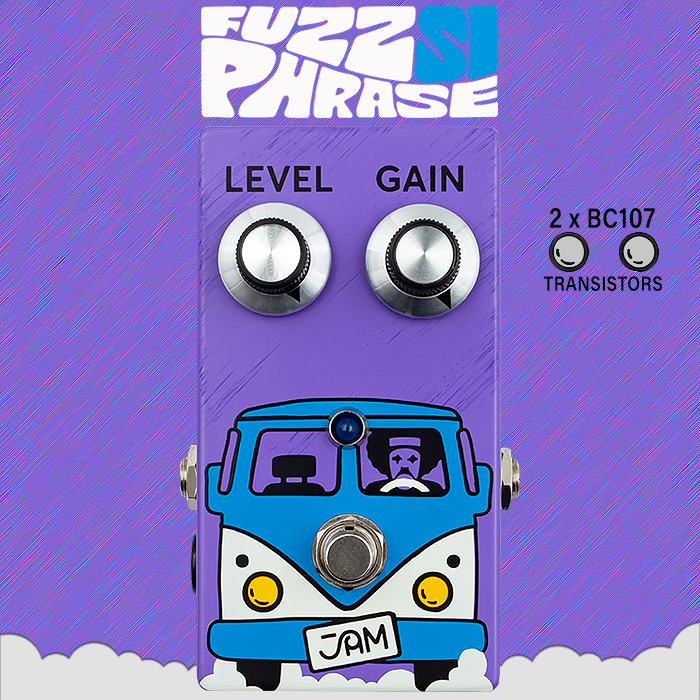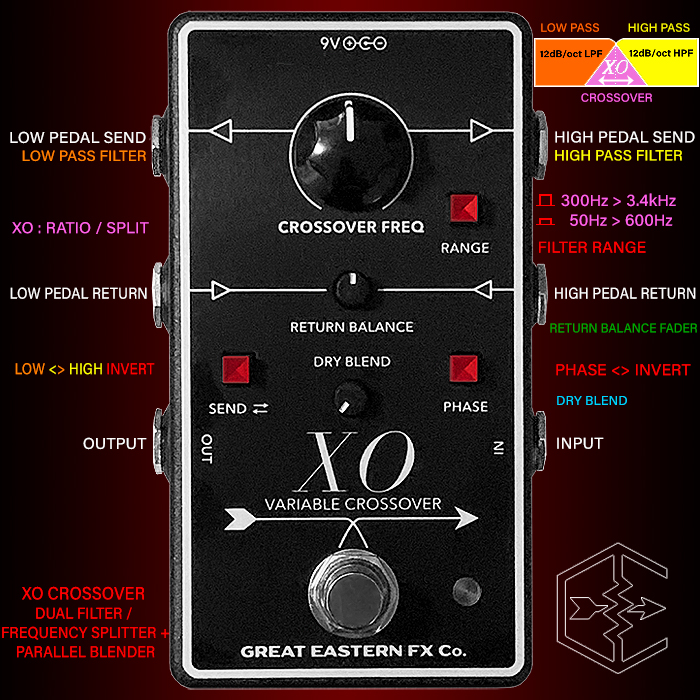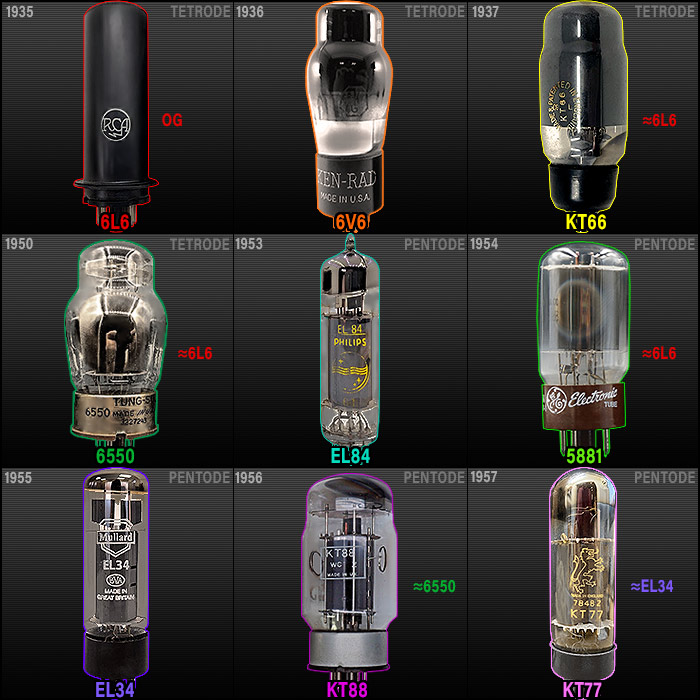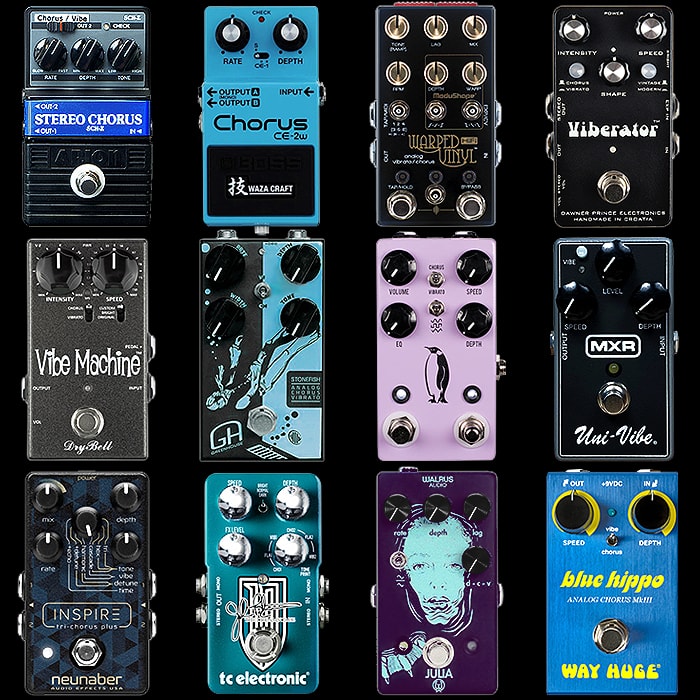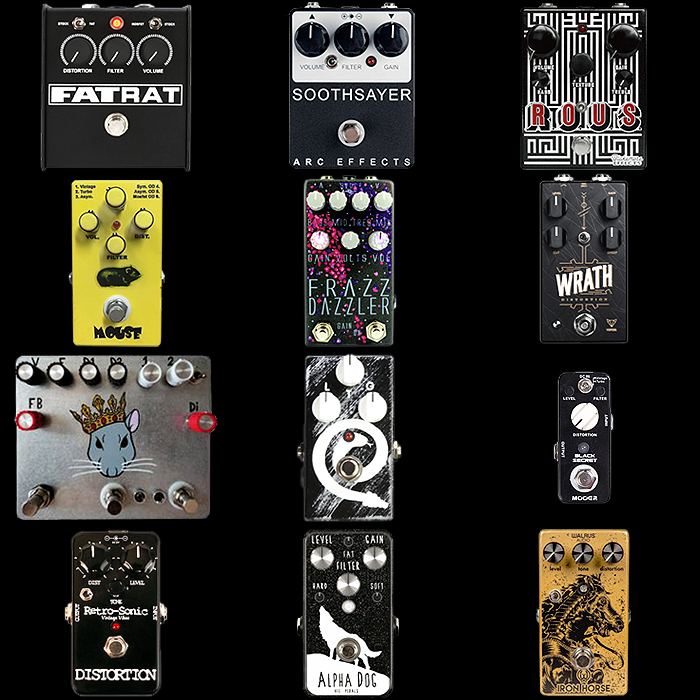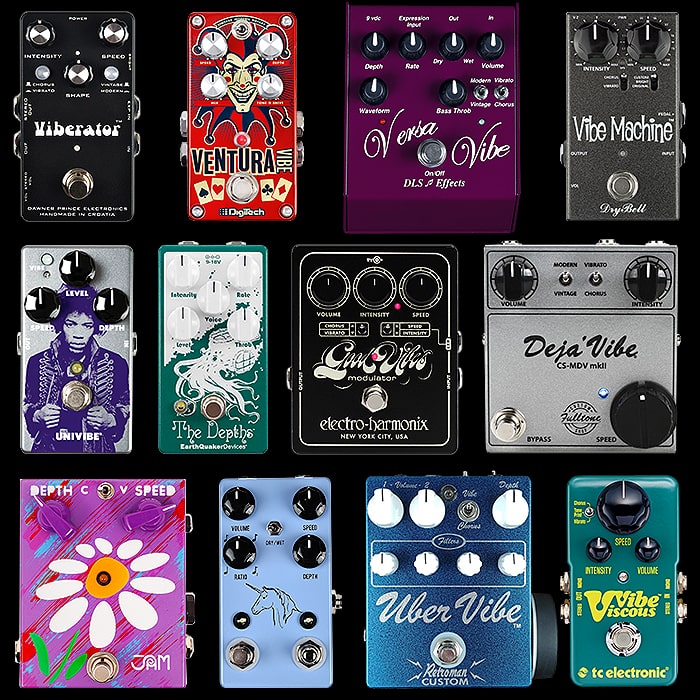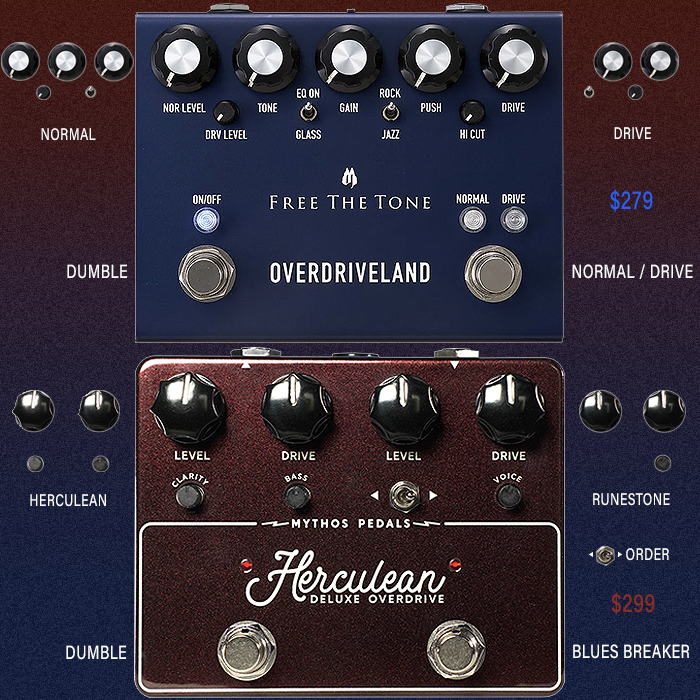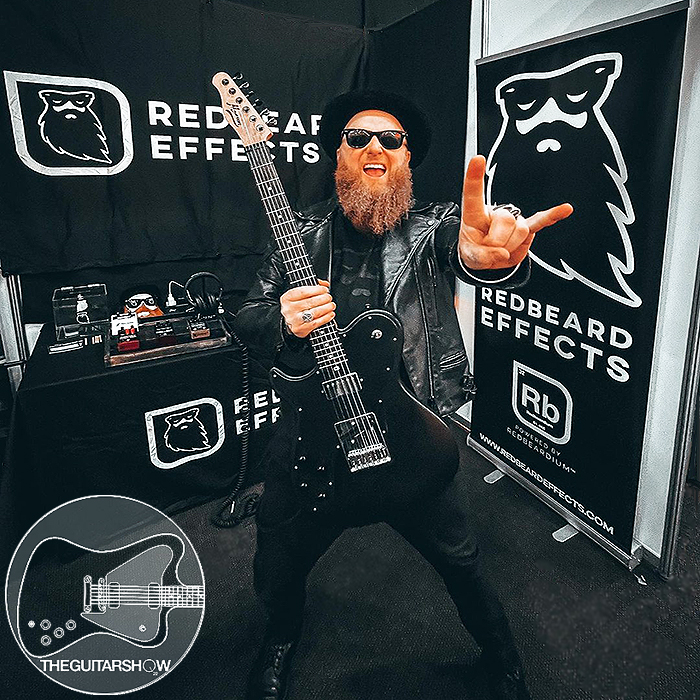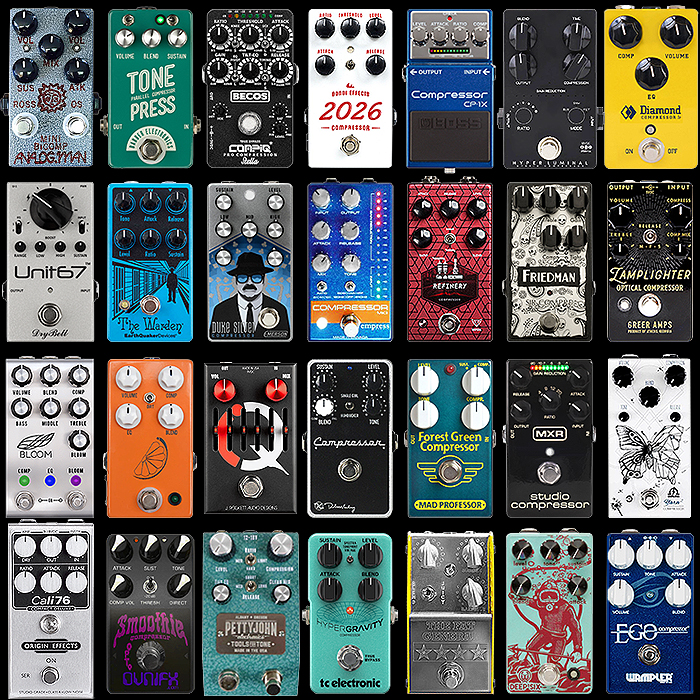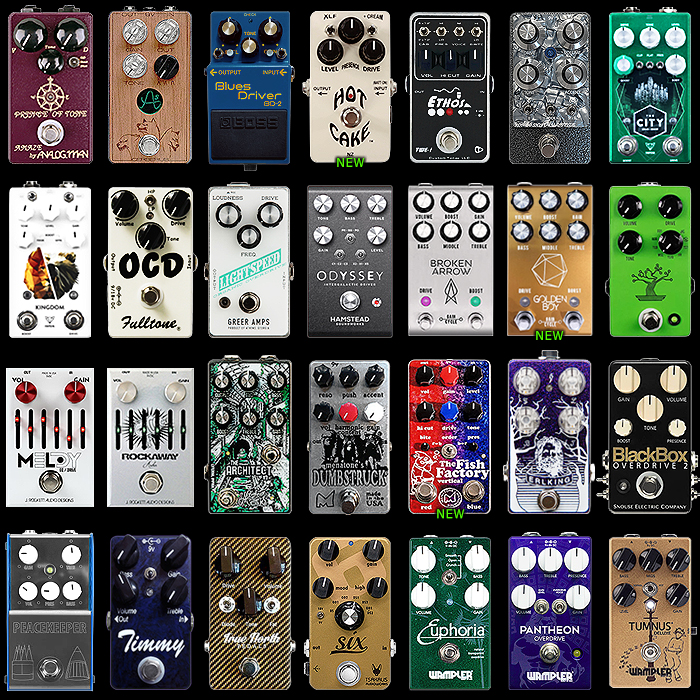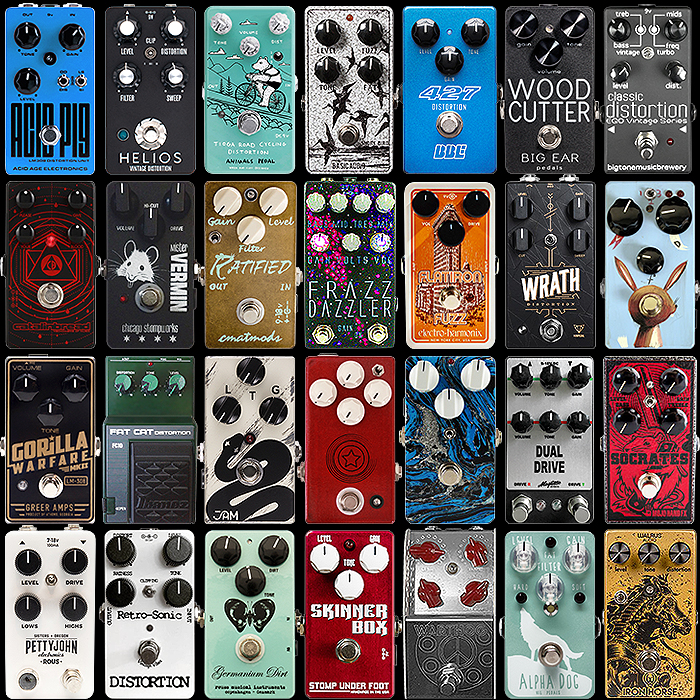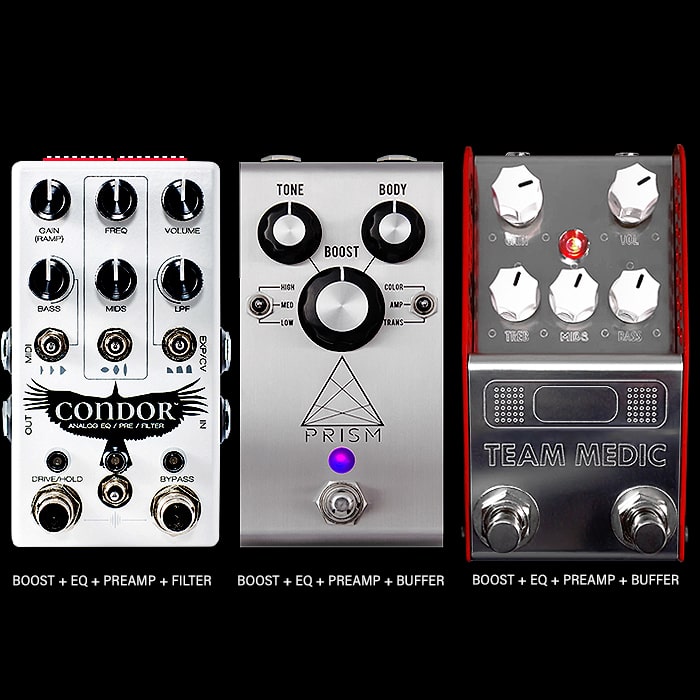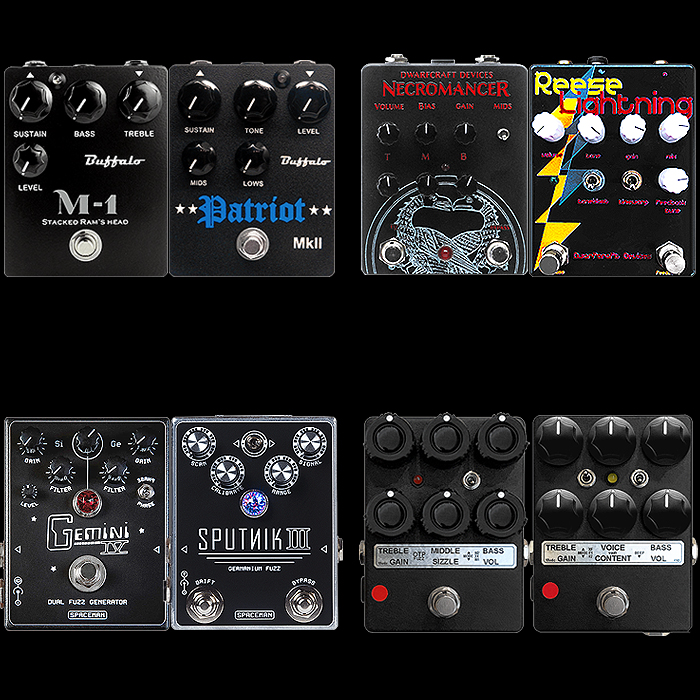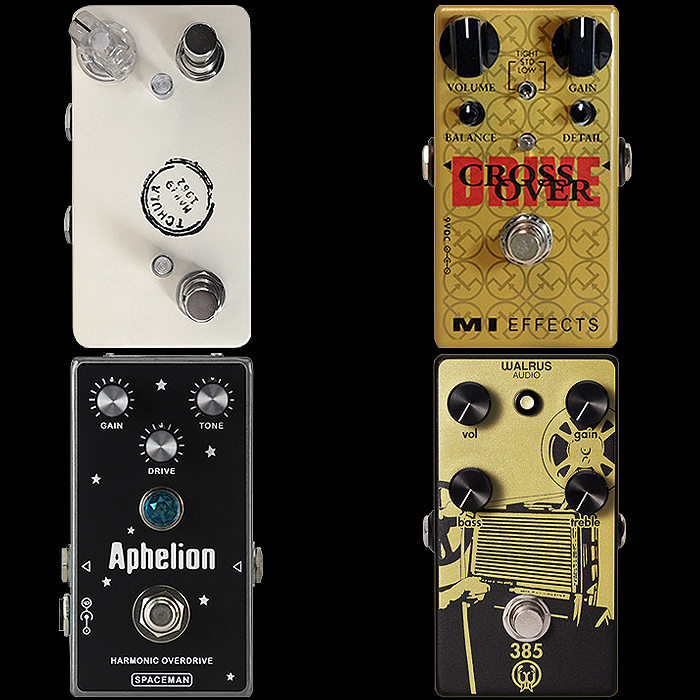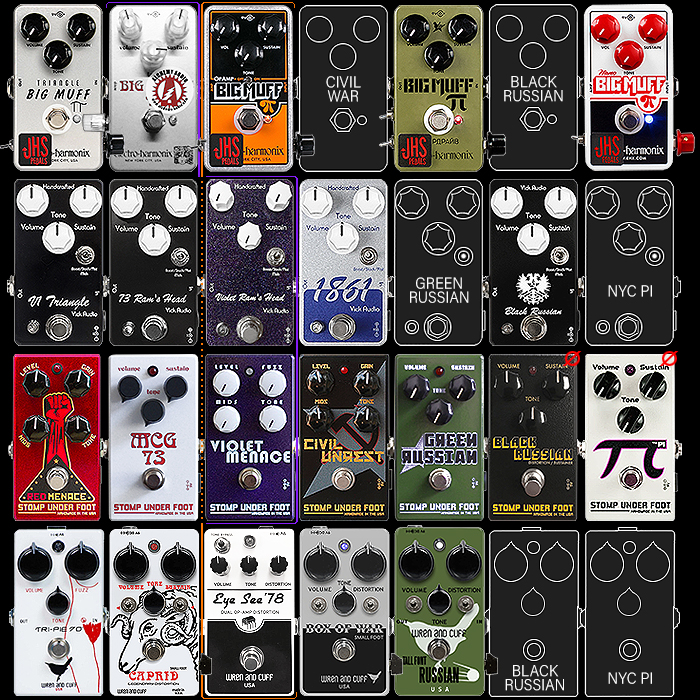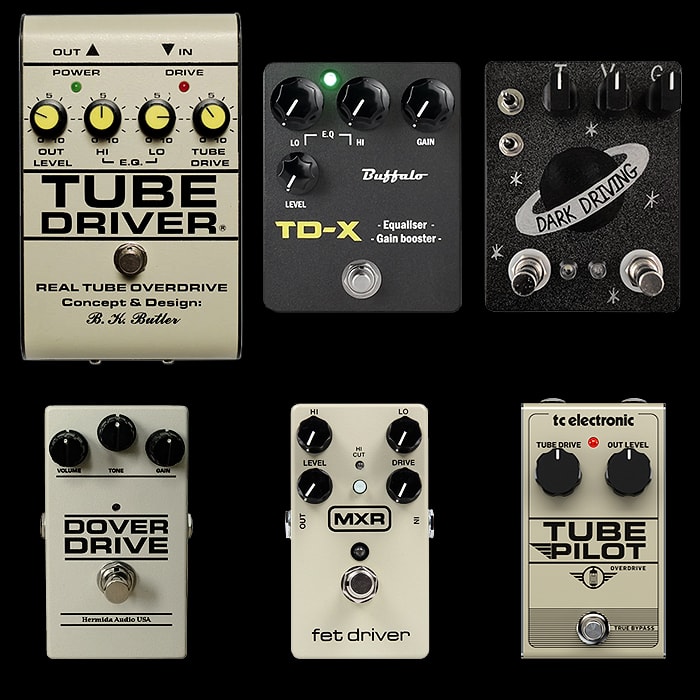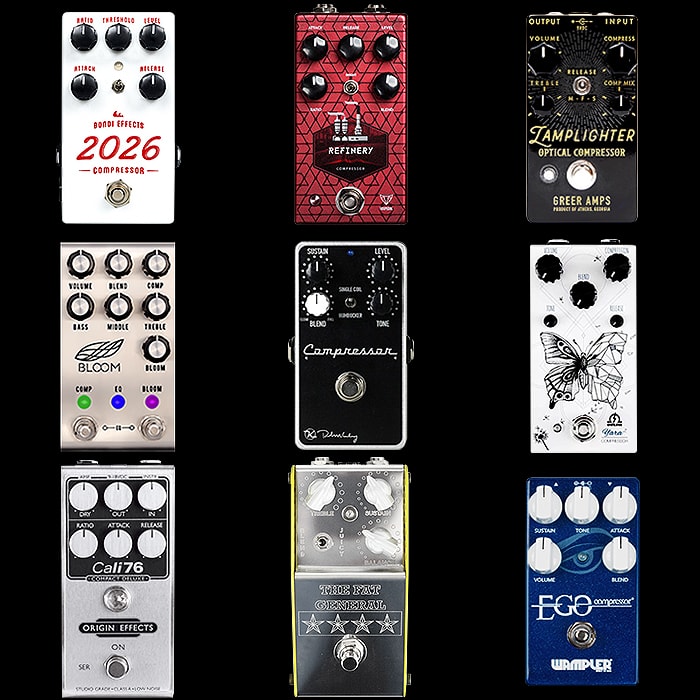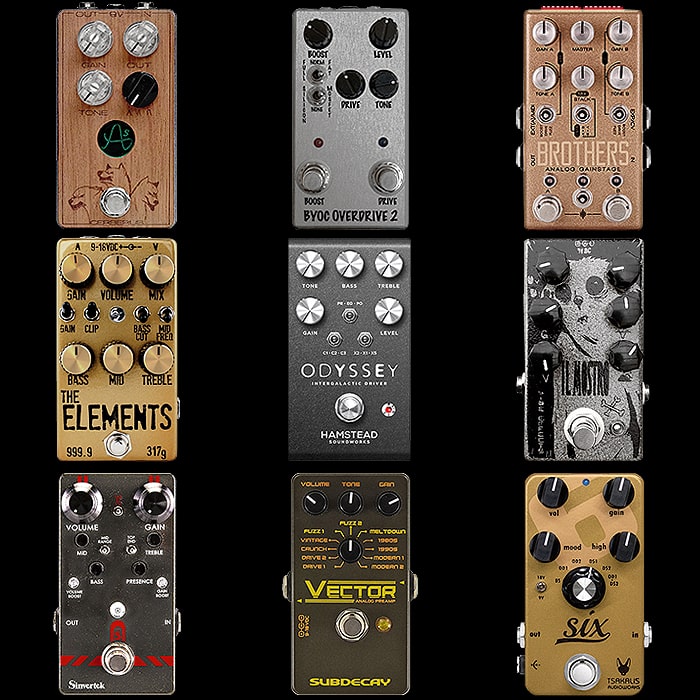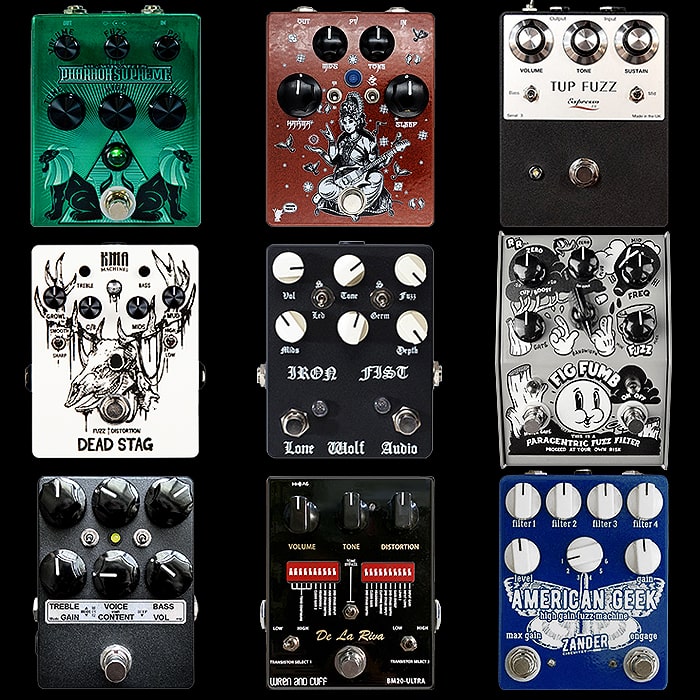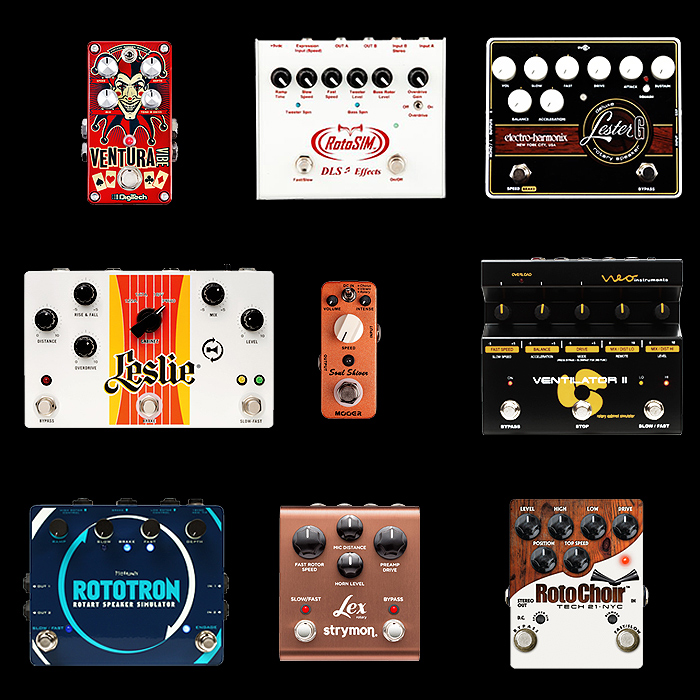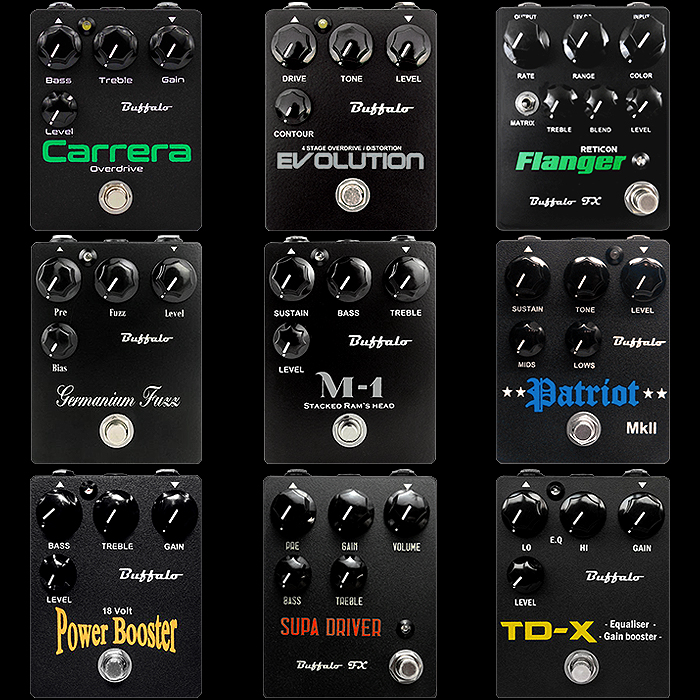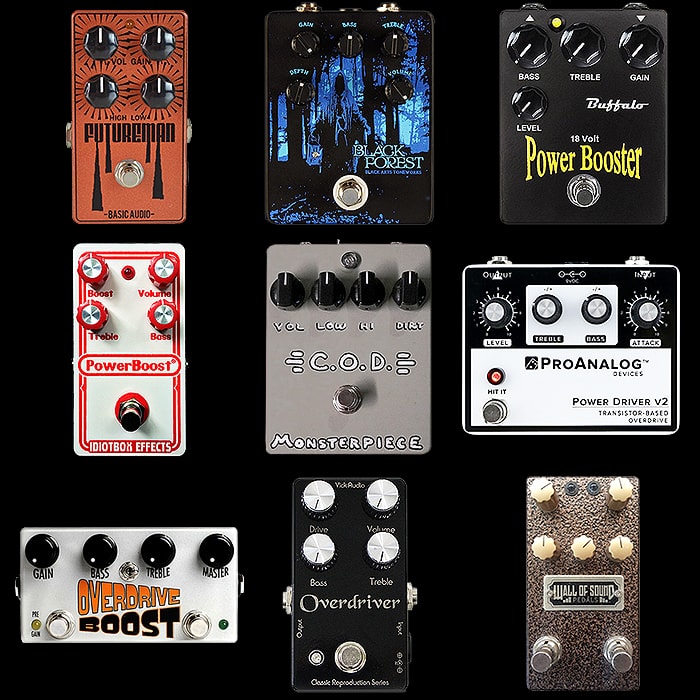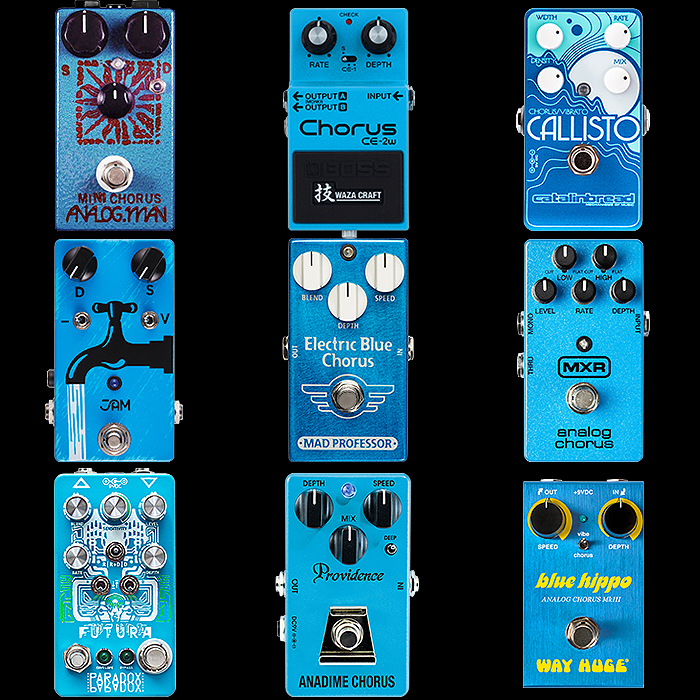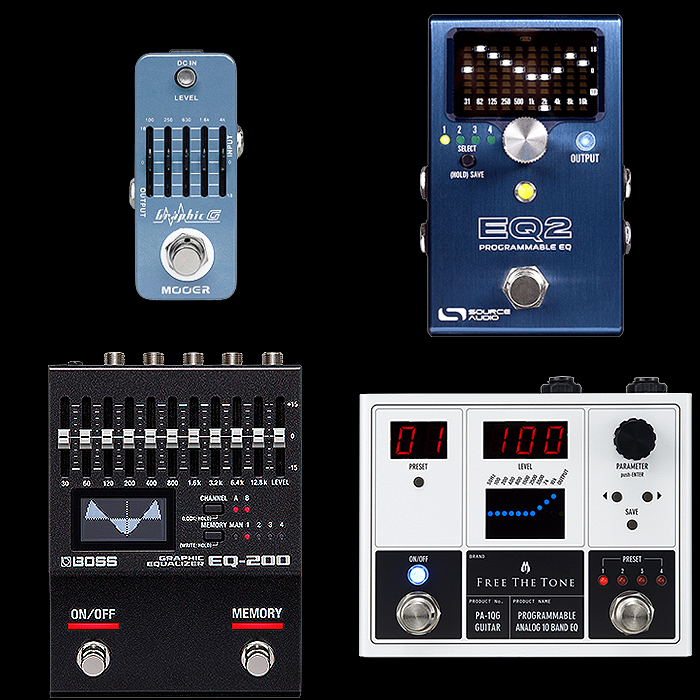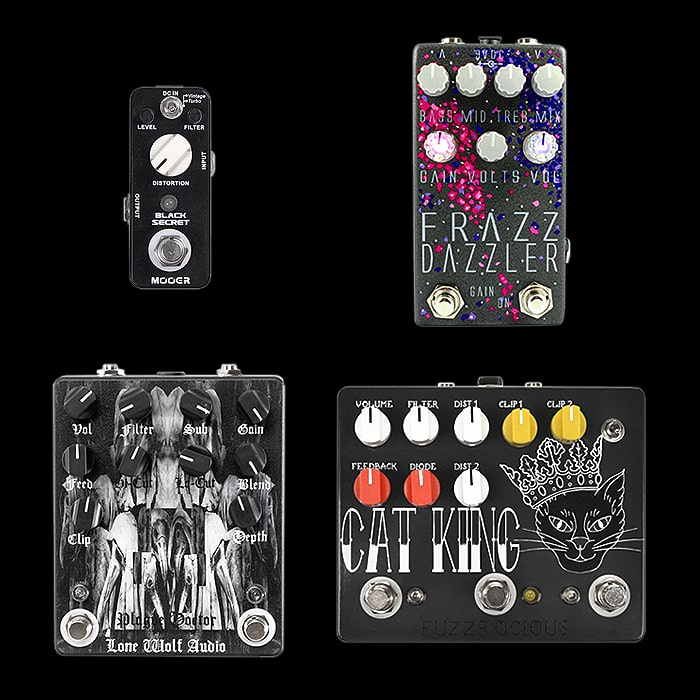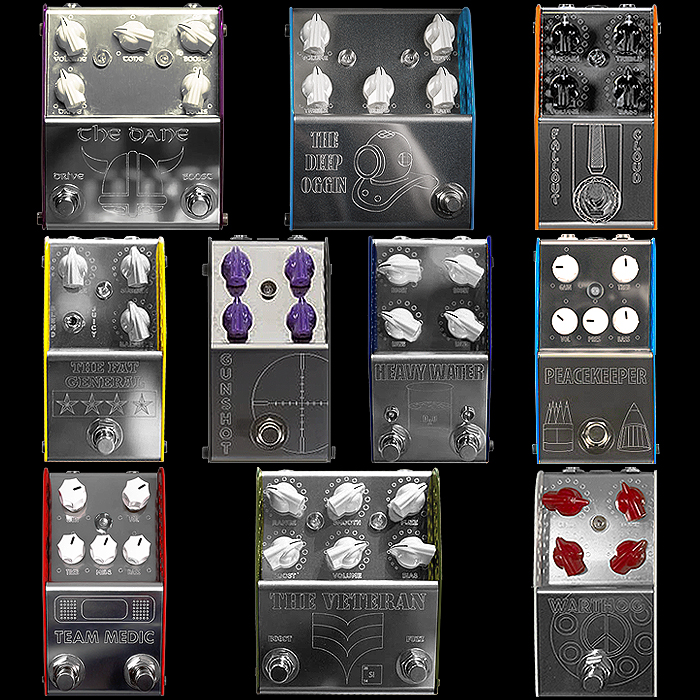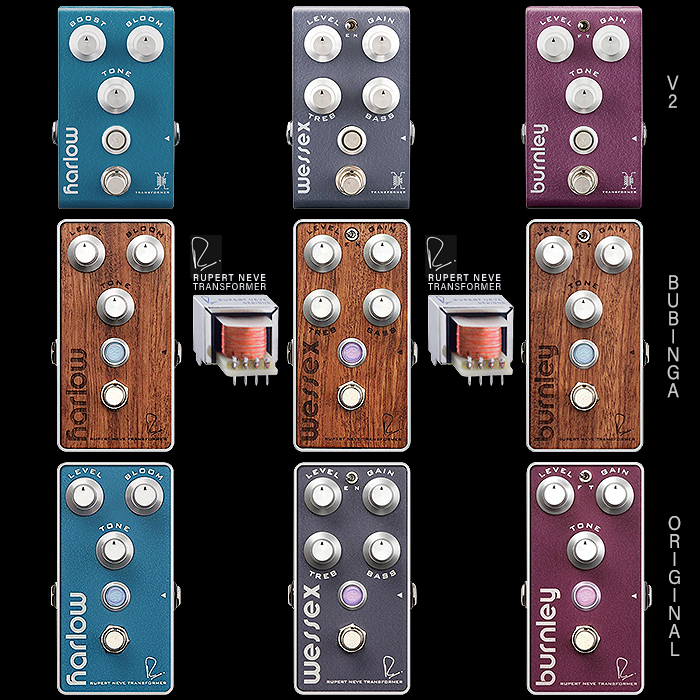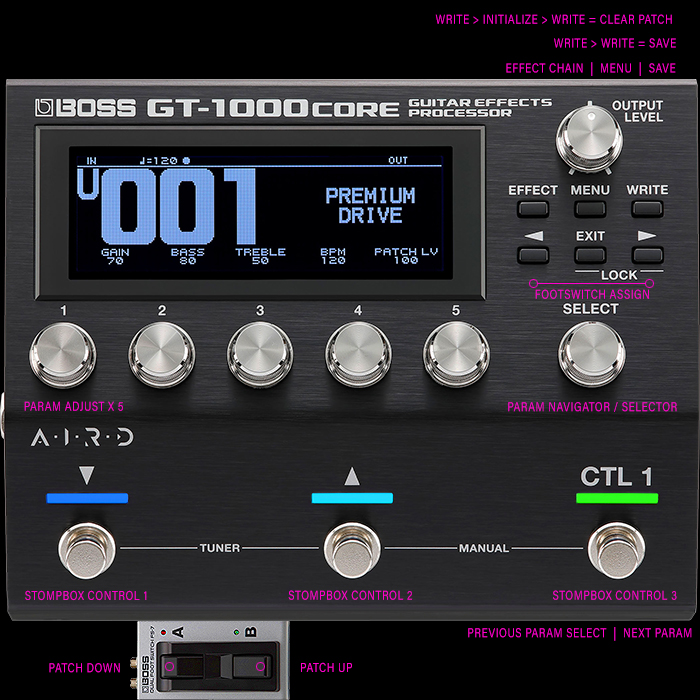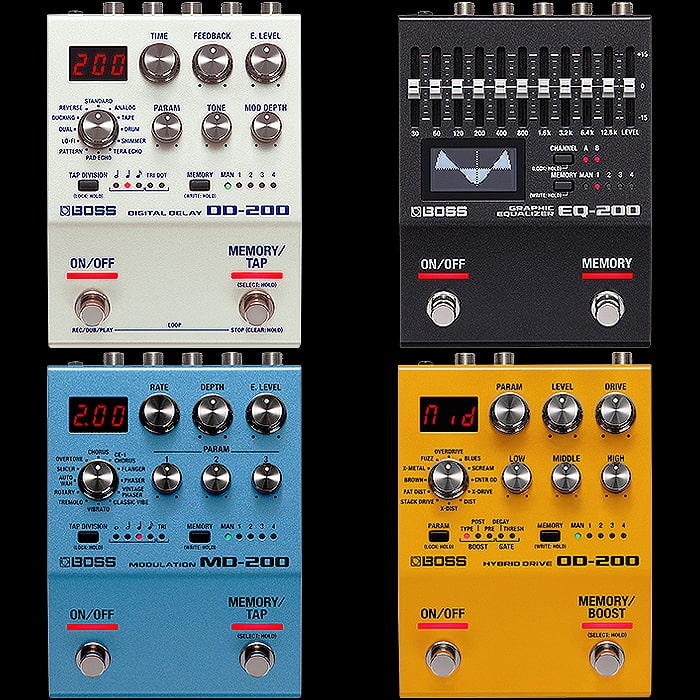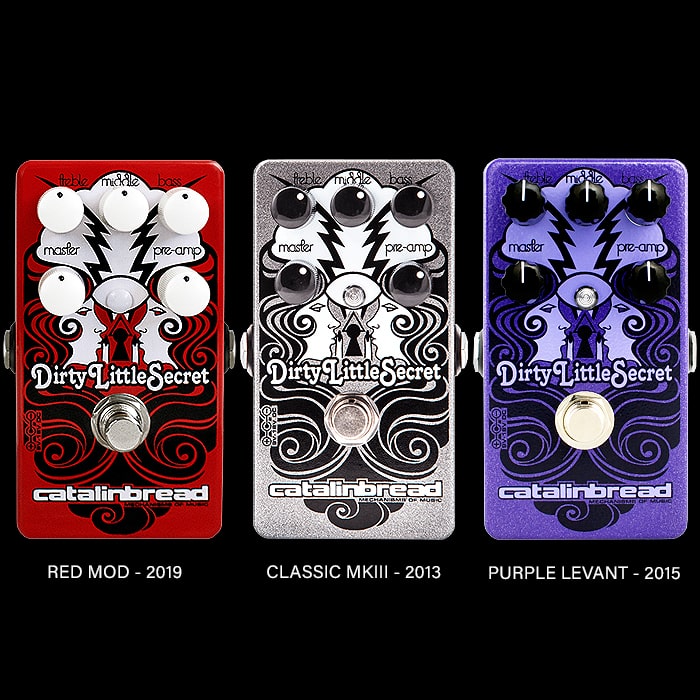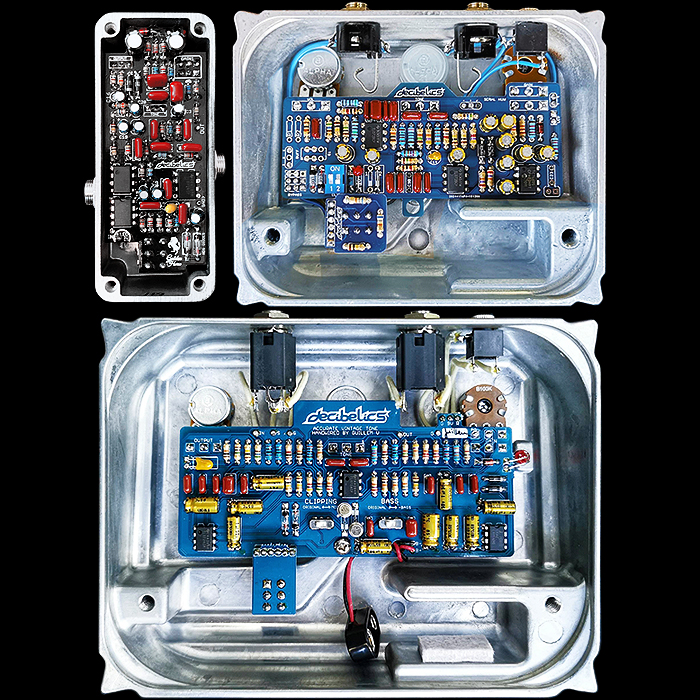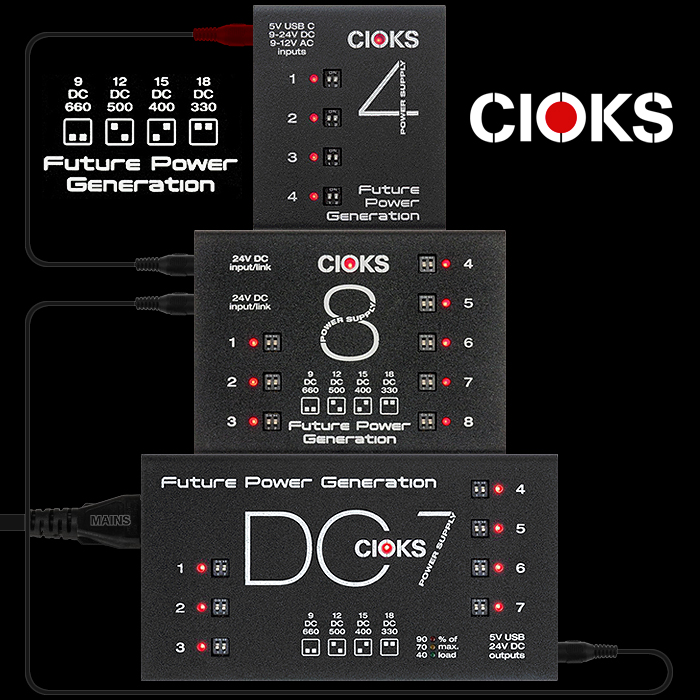Steve Mac's Home Studio 'Wall of Sound' Pedalboard Dynamics and Essential Tone Components
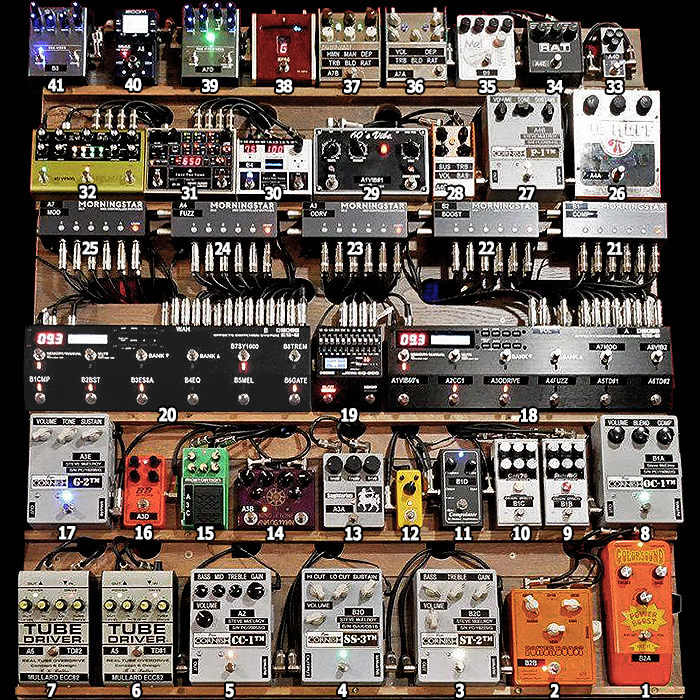
I would like to start by thanking Matt Knight and Joe Branton of Guitar Nerds who made this all possible and put me in contact with Steve Mac - guitarist and original member of the Australian Pink Floyd. This all stems back to the Guitar Nerds’ podcast for Friday 3rd July - an interview with Steve Mac, and the accompanying social media pictures of Steve’s home studio pedalboard - or literally ’wall of sound’.
I’m a considerable Floyd and Gilmour fan and avidly follow Björn Riis’s Gilmourish website too and video excursions. I’ve known about the Australian Pink Floyd for years and am very familiar with their superb high standards of authenticity - although I’ve not yet been fortunate enough to attend one of their fabled live shows. The APF have a been running now for longer and more consistently than the original Pink Floyd, having been established back in 1988 with Steve onboard right from the start. If any of you doubt APF’s virtuosity and craft - you should know that they played at David Gilmour’s 50th birthday at his behest - the strongest possible endorsement you could get!
On to the pedalboard then - there is a lot to get through here - including the David Gilmour way and methodology, and how these pedals might be arranged and deployed to recreate every sound from Pink Floyd’s diverse 15 studio albums. Pink Floyd would spend as much as a couple of years touring their new material before they were happy to go to the studio and record the latest best evolution of that sound for posterity. This is the antithesis of modern music making where typically the album comes first - and a lot of time is then spent figuring out how to recreate all that studio-trickery on the road! The pedalboard featured here is Steve’s sound exploration board - not just for recreating those classic Floyd tones, but experimenting with his own music too - so this covers a very wide remit.
In this particular case, and looking at it in organised sections, we have different selections or segments of tone components controlled through twin Boss ES-8 switchers and 25 Morningstar Loops (5 x ML5) as such. There are 34 active pedals or tone components here - with 10 x Boost/Overdrive pedals (duplicates will be explained in a moment), 5 x Compressors, 4 x Fuzzes (Muff), 3 x Distortions, 3 x Analog Modulations, 3 x Digital Modulations - including a Trem/Verb, 2 x Delays, 2 x EQ’s, 1 x Vintage Keyboard Emulator, and 1 x Tuner!
Steve Mac supplied me with such detailed and precise explanations that I will use his own words wherever appropriate (and edits thereof) - indicated by quotation marks. Most should be able to see an evident overlap of certain pedal types - and duplicates even - which are actually an essential part of this methodology, as without digital pedal versions of those effects with presets - each pedal becomes its own ’preset’ as such, and where there are duplicates and overlaps it is because different variations of tone and texture are required from that same or similar type of unit. Those pedals are each used for a specific enhancement and application and can be stacked and combined for special purposes.
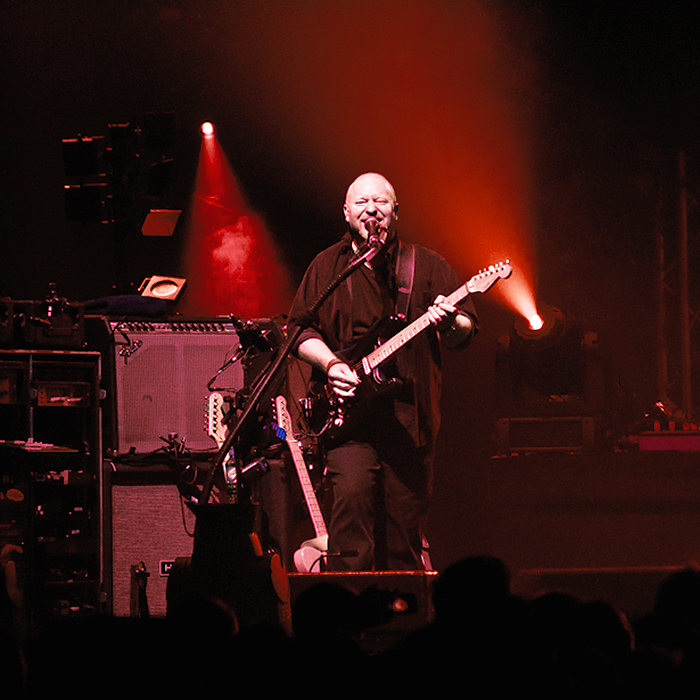
Steve explains further :
"I use the ML5’s (Morningstar) in categories - Compression, Boost, Overdrive, Fuzz & Modulation. For example if I want compression, I have 5 different types of compression to choose from. I can stack them if I wish and also place them wherever I want in the pedal order (courtesy of the ES-8 Switchers). It’s quite interesting trying unconventional pedal orders and certain pedals behave totally differently depending on what their neighbouring pedals are. Impedance plays a big part in this and pedals like the Tube Drivers are particularly fussy about their neighbours - so being able to change the pedal order quickly and easily is really convenient."
"I’ve always used two Powerboosts - simply because my pedals are typically out of reach in a rack. I use one as a treble booster and the other as a bass booster. When stacked - they produce good sustain whilst remaining very dynamic."
"I also use the two Tube Drivers for different purposes. One is set very clean and is used to round off harsh fuzz tones and add some warmth. The other has a small amount of gain and is boosting the midrange to produce a very vocal sound that is still quite open on the high frequencies. I also change the valves in the Tube Drivers depending on what sound I am chasing in the studio. Different gain valves make a huge difference."
Steve made the gorgeous above composition on this very Home Studio rig and utilising the Colorsound Powerboost, Origin Effects Slide Rig Compressor, Demeter Compulator Compressor, Ibanez Mostortion, Free The Tone EQ, Free The Tone Future Factory, Boss EQ-200, and Strymon Volante.
In doing the research and rationale on this particular arrangement of pedals, I came into this process with not that clear of an understanding of the Pete Cornish phenomenon - and approach to sound-design. In the process of doing this feature I've realised that Pete Cornish very much has the 'Tone Components' philosophy deeply ingrained within each of his pedals - and that these are very precisely and carefully calibrated tone machines - each of which solves a very specific application.
When you look at the extensive Pete Cornish range - whether the Big Grey Pro Boxes (as here) or the more modern Black Deluxe Editions (BB-enclosures) - you quickly come to understand that each of these pedals has been designed typically for a really very narrowly-defined and specific purpose. Each of the Boost and Overdrive pedals for instance step up their gain range in logical progressive increments - so it's not just a matter of distinct tonality - but what level of gain/distortion/saturation you specifically need for that application.
Steve has commented on the precise and reliable nature of Pete Cornish pedals - in that you exactly know what you're getting from each of those pedals and the tapers and sweeps of the knobs are so precise that adjustments are immediately intuited and super rapidly achieved.
In terms of a final numbers roundup before we go into individual details - obviously Pete Cornish features the most heavily here with 6 pedals. It's nice also to see my friend Adrian Thorpe represented by a trio of his finest here. We also have the Boss trio at the centre of operations, a brace of Tube Drivers, Origin Effects, Electro-Harmonix, Free The Tone and Fender pedals. I'm also delighted to see a significant overlap with my own pedal preferences here too - as I have a number of these and associated or adjacent selections in my own collection and pedal-chain - while the Strymon Volante and ThorpyFX Camoflange here are the only two currently active in my own pedal-chain!
I consider a number of these pedals somewhat impractical for my own needs - I think most of my readers know how I feel about big box pedals in general. While there are many 'Tone Components' here I actively subscribe to, have in my collection or am in the process of acquiring too. Interestingly the total number of pedals here including utilities is 41 - which exactly matches that of my own current pedal-chain!
Here follow the individual details :
01 : Colorsound 'Aussie' Power Boost - £279
Originally done as a sort of favour / special edition modified Power Boost with master volume on the side - by Macari's of Charing Cross Road (formerly Denmark Street), but now produced by the same in limited quantities to the exact same specifications - and listed as the 'Aussie' Power Boost. Note that there is a waiting list for this item - which is kind of made to order to a degree, or in very small batches. The Colorsound Power Boost is one of The essential David Gilmour pedals / Tone Components - and the modifications here make it 'cleaner' for a longer sweep of the essentially drive / boost knob - or higher headroom really before the onset of breakup. Steve uses one as a treble booster (presumably this one) and the other as a bass booster (below). When stacked, they produce good sustain whilst remaining very dynamic. I am personally quite a fan of the Power Boost, but not really of this oversized enclosure. I did a Power Boost roundup a while back where I indicated some of my preferred choices - I actually wanted a rare 'Wall of Sound' variety that has not materialised on any site since, and I've been sort of chasing down an original ThroBak Overdrive Boost in V1 vertical configuration. I eventually acquired the excellent Basic Audio Futureman equivalent, but currently am probably angling towards the recent Buffalo FX Supa Driver derivation. If you want to be fully authentic though - you would need to go for the 'Aussie' variety Colorsound Power Boost from Macari's!
02 : Andy Betts 18V Powerboost clone - £POA
This second of Steve's Power Boosts is a clone of the above Aussie variety, but upped to 18V supply for even greater headroom - otherwise I understand that the circuit is pretty much identical. This is presumably used as a bass booster in conjunction with the treble boost function of the previous one (or vice versa). These pedals are all made to order - and you will need to contact Andy Betts via his site Andy Betts Music to commission one for yourself - pricing depends upon availability of specific components and your own preferences and requirements - but in theory should be around the same price of the Colorsound original. Andy Betts has become a good friend of Steve's over the years and he performs in his own Pink Floyd Tribute Band - Eclipse. Where he started making David Gilmour style pedals / clones for his own performance needs. Andy currently builds highly authentic versions / clones of the Ram's Head Big Muff, Black Russian Big Muff, Green Russian Big Muff, Power Boost/Powerboost, Fuzz Face, Clean Boost, and Brian May Treble Boost - mostly in BB-style enclosures as far as I gather. I was unable to find any specific YouTube demo featuring this particular pedal - and will of course add one if such materialises later on.
03 : Pete Cornish ST-2 - EQ / Tone-Shaper / High-Headroom Clean Boost - £490
And so to the first of the Pete Cornish pedals - which is largely a Tone-Shaper / High Fidelity, super clean high headroom EQ - so somewhat adjacent to the super high-headroom Power Boosts at the start of the chain. Obviously if you max the gain you can drive the front of your amp for some overdrive tones too - but this is more intended as precision tone-shaper. According to the dials in the reference, this looks to be set up as something of a Bass-boost currently - with Bass at 4 o'c, Treble and Gain at 2 o'c and Volume at unity.
04 : Pete Cornish SS-3 - Crunchy / Bluesy Overdrive / PreAmp - Soft-Sustain - £450
This is the first of the Pete Cornish Overdrives here - with that lovely sustaining bluesy break-up tone. These Pete Cornish pedals have such a distinct tonality which is so evocative of vintage rare-component / transistor and valve gain effects - there's something really special about the character of the breakup that just sounds unique. Sure you could find some near matches, but nothing I'm aware of that would match this tonality exactly - or certainly not out of a single equivalent pedal necessarily. Gorgeous bluesy drive tones.
05 : Pete Cornish CC-1 - 2-stage low-gain soft-clipping crunch overdrive - £530
I've referenced the above video as the classic incarnation of the CC-1 tone in combination with a vintage EHX Electric Mistress Flanger and a Free The Tone Flight Time Delay. Just one of David Gilmour's many legendary tones, and easily one of my favourites. If I were in a position to acquire any of the Pete Cornish pedals - I would get this one in its slightly more compact BB-style Black Deluxe enclosure. This is a beautifully harmonic drive with an exceptional sort of almost fuzz-like transistor-style breakup - which I hope to successfully recreate on my recently arrived Catalinbread Gyigas Fuzz with the Fuzz cranked back, and the Dry-Blend elevated! Actually the Pettyjohn Rail at low clip seems to hit pretty close too.
06 : B.K. Butler Tube Driver 5K - $424
I have referenced these proper tube-driven pedals several times on this site and listed out various alternatives - while I've still to pull the trigger on an acquisition in this category - where the likeliest candidate for me is the Buffalo FX TD-X. The original BK Butler varieties can obviously sound amazing, and are another of those synonymous Gilmour sounds alongside the Power Boosts and Big Muff Fuzzes. Yet these boxes are fussy as hell and have a super high degree of reactivity and influence on any surrounding pedals - and buffers and impedance in particular. Many players complain that the Tube Driver can overly dominate the tonality of the signal chain - where it imposes its character over everything else. Steve mentions how he uses his two Tube Drivers for different purposes. One is set very clean and is used to round off harsh fuzz tones and add some warmth. The other has a small amount of gain and is boosting the midrange to produce a very vocal sound that is still quite open on the high frequencies. Steve also changes the valves in the Tube Drivers fairly regularly depending on what sound he is chasing in the studio. Different gain valves make a huge difference - and he currently seems to be favouring the Mullard ECC82 varieties. Joe Perkins does another superb demo here - which will suffice for both this and the 4K reference below.
07 : B.K. Butler Tube Driver 4K - $299
The only significant difference between the first and second Tube Drivers here is that the first has an additional 5th control in the guise of a variable Bias Knob on the rear of the unit - a difference that adds $125 to the price tag - but obviously gives you a lot more precise fine-tuning over the behaviour of its single tube. This pedal is largely here because of how Steve uses his two units in rather different ways - and if you can afford it - it's obviously less hassle to have two units set to the most regular settings, than having to constantly re-calibrate and tweak a single pedal towards those preferred settings. As mentioned in the intro - there are times too when Steve stacks several pedals together for particular applications - which I'm pretty sure is not the case for the Tube Drives because of their inherent sensitivities. Please refer to the above 5K demo video for sound samples.
08 : Pete Cornish OC-1 - Optical Compressor - £447
Compressors are another essential of that Gilmour tone - to delivery those sparkly and sustaining higher frequencies in particular. This is the first of no less than 5 mostly optical compressors - all of which are set slightly differently to serve different frequency clusters and tonal applications. Steve uses these both individually and stacked, and via the Boss ES-8 Switchers - where their order can be shifted in all manner of different ways within the signal chain. I would personally question the need for quite such a large compressor in the rig, but with Pete Cornish you know it delivers something precise and unique which the others cannot. I actually really like seeing the selection of compressors in descending size order, and the fact that Steve has found use for a Mini Mooer Optical Compressor in line with all these other somewhat more pricey boutique varieties.
09 : Origin Effects SlideRig Compact Deluxe Compressor - £299
Steve talks about the Gilmour Seagull effect in the song Echoes - which is actually just a reverse sweep wah. Before Pete Cornish let him in on the secret - Steve was playing this by using Slide-technique on his regular guitar - where obviously the SlideRig compressor comes in handy for those sort of tones. A lot of Gilmour's solos have that sustaining slide quality - and no doubt this pedal comes in handy for just those kinds of occasions.
10 : Origin Effects Cali76 Compact Deluxe Compressor - £259
It's no surprise to see the de facto Pro Guitarists' Compressor Pedal of choice in this selection. Origin Effects are probably the most featured Compressors now on pro pedalboards - and it's usually the Cali76 Compact Deluxe variety. I of course went for the Jackson Audio Bloom instead being the maverick that I am - which gives me analog compressions, but with a 6-preset digital control surface - and with optional foot-switchable 3-Band EQ and optional foot-switchable Blooming Boost. So I largely have a lot of what Steve has here in several units - in just one - albeit I can't stack those presets together! I had for a very long time considered the Cali76 CD and was right on the cusp of getting one when the Jackson Audio Bloom materialised. I still feel the Cali76 is probably the reference standard for pedalboard compressors - and may very well acquire on of these in the end anyway! Actually I mustn't forget to mention Becos FX here either - whose compact Stella CompIQ Pro Compressor is the most fully featured variety yet - and about as close to a studio compressor as you can get in a pedal format.
11 : Demeter COMP-1 Opto Compulator Optical Compressor - $269
Another optical compressor which is seemingly less in circulation nowadays - in fact I overlooked it when I did my last 28 Compact Compressors overview - I just don't see it on that many boards nowadays. Obviously still a classic variety though, and it gives Steve something slightly different to what these others deliver. I know Demeter best for their Reverbulator Spring Tank Reverb - both that and the Compulator are just excellent high fidelity quality and come highly recommended.
12 : Mooer Yellow Comp Mini Optical Compressor - £49
And finally! The 5th and last of the Compressor selection is this diminutive Mooer Optical Compressor - based on the Diamond Pedals variety as far as I'm aware. I love seeing the different mix of pedals in Steve's selection - and most people are now very aware that there are a number of Mooer pedals which are actually pretty rather decent - most of which I've covered variously on this site before - although not sure I've focused too much on the Yellow Comp which is one of those that gets a lot of love.
13 : Giuseppe Bagnara Sagittarius Overdrive (Klon Klone) - NFS
This is a very special Klone variety - significantly modified from a 2008 circuit schematic of the original Klon Centaur. Now a long-term friend of Steve's - Italian engineer and sound-designer Giuseppe Bagnara made this as a gift for Steve many years ago - he thought Steve would appreciate the special tones generated by this pedal. Giuseppe kindly shared the schematic with me and his notes on how he re-engineered the circuit to his own preferences and sensibilities - I can tell from all the work and smart decision-making that went into it that this is most definitely a Klon Klone of the highest order. Giuseppe's final circuit is significantly different to the original schematic as he majorly adjusted key parts of the circuit such that they sounded better to his ears and touch sensitivity. If you are hoping for one of your own of these though you need to be aware that Giuseppe just makes pedals as a hobby in his spare time for friends and family - and extremely rarely as such - and as far as I understand - this specific 'Sagittarius' labelled/branded pedal is/was a total one-off. I was unable to source a demo video of this specific pedal - while the vast majority of players should be very familiar with the Klon sound - and could surely imagine an enhanced extremely dynamic version of that. In the absence of the availability of further Bagnara Sagittarius Klone editions as such - I obviously highly recommend the Klones of my good friend Guillem Vilademunt of Decibelics fame which I firmly believe are the best currently available.
14 : Analog.Man King of Tone Dual Overdrive (TS + BB) - from $265
I've featured the King of Tone several times on this site - I of course have the JHS 4-star modded edition of this pedal with the interior switches and presence controls externalised. I really feel that everyone should have one! - while there are of course excellent alternatives to this too - like the Browne Amplification Protein Drive, JHS Double Barrel, Keeley D&M Drive, King Tone The Duellist and VS Audio Royal Flush to name a few.
15 : Ibanez MT10 Mostortion MOSFET Distortion - discontinued - c$350 for pristine second-hand example
It's not long since I did my Mostortion pedals roundup with all the recent suspects. I would quite like an Ibanez original - it's the only one of the 10 Series that I'm interested in. But currently prices are ridiculously high and pristine versions exceedingly difficult to come by - I have various keyword feeds active, but will in any case be acquiring the Danelectro Roebuck version as an interim measure. There is something really special about the original Ibanez Mosfet units - I'm sure there is a fabled dividing line there when something changed in the circuit or assembly - but it's the original versions that are the most sought-after and they're typically around the $350+ mark currently even for just good to very-good versions - while I typically try to source 'Excellent' or 'Mint'.
16 : Xotic Effects BB PreAmp - £142
Another exceptional Boost/Overdrive pedal - with up to 30dB+ of Clean Boost and ±15dB on its two band Baxandall style active EQ. This has understandably been a hugely popular pedal over the years with various artist editions too including an Andy Timmons variety. It's interesting to see just how many boost type pedals there are in Steve's lineup - I totally understand that philosophy as I have several in mine too! If you set each of them just right you can have the most amazing stacking combinations. These are essential elements of the whole 'Tone Components' philosophy as there are lots of different kinds of 'boost' including compressors and harmonic texturisers / 'sweeteners'. I in effect have 3 'boosts' right near the start of my own chain - Jackson Audio Prism PreAmp Boost, Jackson Audio Bloom Compressor and Thorpy FX Heavy Water Dual Boost - these are essential components to my clean-pedal-platform signal chain - to add dynamics, sparkle, warmth, definition and harmonic texture - and to enable fully 'saturated' tones at relatively low levels of output!
17 : Pete Cornish G-2 - Overdrive/Distortion - £555
This is supposedly modelled on those 70's Jimmy Page Super Lead Plexi tones - and has a superb distinct, crips and crunchy character profile enhanced by several rare germanium diodes - with really finely calibrated frequency clusters and gorgeous harmonic texture and sustain. I rather love the tone of this unit too - and it would be my second choice Pete Cornish pedal after the CC-1. And while I have numerous Plexi varieties in my own collection - including the Menatone KOB Vertical edition currently in my pedal-chain. I have nothing which sounds exactly like the G-2. I recently reviewed the DryBell The Engine PreAmp - which is exceptional and will likely get you closest to the the G-2 tonality, while my next Plexi-style pedal will probably be the Bogner La Grange - which I've been meaning to get for years, but never quite got around to! Had I unlimited funds - I would most definitely get the Pete Cornish G-2 and CC-1 pedals in their BB-sized Black Deluxe form-factor - but we are talking well over a grand for the pair!
18 & 20 : 2 x BOSS ES-8 Programmable Effects Switching System - £579
These are pretty much industry standard Loop-Switchers / Midi-Controllers and are well up to the task here for those more advanced multi-loop applications. They're right on the cusp of where I would be considering TheGigRig G2 controllers too as alternatives - while the two Bosses do also cover most of that ground - including the essential ability to shift the order of the loops. I'm obviously a huge Boss fan, and considering how Steve and his Aussie Floyd bandmates started off with mostly Boss and Ibanez pedals in their rigs - I might just be a tad disappointed that no further Boss pedals than those 3-in-a-row featured made this selection!
19 : Boss EQ-200 Programmable Graphic Equalizer - £188
The 2nd of the Boss trio all in a line - is the superbly capable EQ-200 Programmable Equalizer, which comes in super-handy with all those midi-activated presets and in tandem with the ES-8 switchers. Disappointingly for those without Midi-controllers there are only 4 onboard presets - 4 x 2 really as you can set a separate profile for each stereo channel. This is the best and most versatile 10-Band EQ currently out there, where the only improvements it could make would be motorised sliders and further onboard presets. I have and love my Alchemy-Audio-modded GE-7 - I don't really currently need the extra 3-bands or presets for my own particular needs - while I recognise the enormous flexibility on offer here - but this remains a nice-to-have for me right now, while I will likely acquire it one day anyway. My whole pedal-chain is sort of overkill to a degree - so my regarding the EQ-200 as a little much is somewhat a strange take in line with that. Probably I'm just keener on acquiring more tone-generating pedals - utility pedals, power supplies and the like have always taken somewhat a lesser priority for me - while I of course still recognise the need to have highest quality components in place there too.
21 - 25 : 5 x Morningstar ML5 5-Loop switchers - $199 x 5
I've featured the Morningstar MC6/8 Midi controllers and ML5 5-Loop Switchers several times on this blog before - usually being used in conjunction with each other. It's cool to see the mix-and-match application here in tandem with the Boss ES-8 units - which generally provide a little more hands-on control than the Morningstar MCs. We're seeing these units used quite regularly now - but I don't often see 5 of them patched up in a row!
26 : Electro-Harmonix Late 70's V3 Red and Black Big Box Big Muff Pi (Ram's Head V2) - discontinued - c£350 equivalent for pristine second-hand version
This relatively early big box version - the originally 1976 V3 Red and Black edition is really mostly just an artwork change to the V2 Ram's Head with some slightly tweaked internals which yield more sustain and aggression than the previous Ram's Head V2 variant. Ram's Head, Civil War and Triangle style muffs in particular were a huge part of Gilmour's signature sound - and this is a slightly fuller sounding version of that. I love the tonality here - but I don't much like the impracticalities of accommodating these now over-sized enclosures.
27 : Pete Cornish P-1 Fuzz (Ram's Head Muff Style) - £541
I believe this is Pete Cornish's take on the Ram's Head Muff - or at least Ram's Head adjacent. It certainly sounds very much in the ballpark of the Ram's Head character. Both these big box editions in Steve's chain are somewhat impractical for my preferences. I have a number of my own favourite Ram's head style compact editions - including the Basic Audio Tri/Ram, Black Arts Toneworks Son of Pharaoh, Electro-Harmonix Alchemy Audio modded Violet Ram's Head, Skreddy Pedals P19, and Wren and Cuff Custom Small Foot Caprid. I still intend to get my hands on a Maxon Fuzz Elements Water FWA10 - and then I will probably call time on that selection as 6 varieties should do me fine! Note that Pete Cornish's P-1 is closer in character to the Ram's Head, while his P-2 'Precision' Fuzz is rather a blend of Ram's Head and Civil War characteristics - each has their own loyal group of followers - while I prefer the specific character of the P-1. I actually really like the sound of the P1 too - but could never see myself owning that in addition to the CC-1 and G2 - which are already a tall order. Besides I own more than 50 varieties of Muff style fuzzes - and most of those are quite superb. So would be very unlikely for me to own a P1 however much I would like too!
28 : ThorpyFX Fallout Cloud Muff Fuzz (Triangle) - £185
Thorpy's most enduring pedal in my opinion and one of his original award-winning trifecta. This is largely a Triangle style muff with 2-Band EQ - and wonderful range and tonality. It's one of my 5 favourite Triangle varieties - alongside the Basic Audio Tri/Ram, Jam Pedals Red Muck V2, Skreddy Mayonaise II and VFE Fiery Red Horse. I've still to get the Stomp Under Foot Red Menace, and I of course have all the recent EHX compact reissues in either JHS or Alchemy Audio modded editions. Triangle is generally my favourite variety of Muff followed by Ram's Head - while I really like all the the core varieties for different reasons - including Civil War, Green and Black Russian, OpAmp and NYC editions.
29 : MJM Sixties Vibe Classic - $385
Steve has tried and trialled numerous Uni-Vibe style pedals over the years - and the MJM Sixties Vibe Classic is his all-time favourite variety. He reports that it just has a richer more visceral texture than any of the others, and he's tried most of the top-tier alternatives. Interestingly his second choice for Uni-Vibe effect is courtesy of his digital Zoom MultiStomp MS-100BT Multi-FX unit which delivers a slightly more subtle flavour - but still with plenty of textural definition. I have to admit that the MJM Sixties is one of the very best I've heard - while the Sabbadius Funky-Vibe and Shin-ei Vibe-Bro should probably also be considered in similar larger form-factor. My preferences as always are for somewhat more compact units - I personally have the JHS Unicorn V2 with onboard tap-tempo, while I also favour the Dawner Prince Viberator, DryBell Vibe Machine, Fulltone Deja'Vibe V2, JAM Pedals RetroVibe, and Retroman UberVibe.
30 : Free The Tone PA-1QG Programmable Analog 10 Band EQ - £349
I've considered a number of EQ's over the years including this digitally controlled one, and the recent Source Audio EQ2 Programmable Equalizer - which does largely the same thing - albeit wholly digitally and in a much smaller compact box. I am personally a tweak-on-the-fly kind of guy - and I get very frustrated by these sorts of interfaces where you have to access each frequency band separately by selecting and tabbing / honing in on that particular frequency column. Much easier for me is the manual hands-on control of the Boss EQ-200 just recently touched on. It's interesting to see that Steve has both the mostly digital Boss EQ-200 with manual sliders and this mostly analog EQ - but with digital edit menus! Obviously each of these yields different results for Steve - which is why both are in the signal chain. I use a number of different EQ's throughout my chain - so I can totally see the benefit and utility in that.
31 : Free The Tone Future Factory FF-1Y RF Phase Modulation Dual Delay - £374
Free the Tone has always done stellar delays - and their sort of airplane console style of a Delay with cool phase modulation and soft clipping is one of the smarter units currently out there - particularly how informative and intuitive the display and controls are. Free The Tone's previous FT-2Y Flight Time delay unit had an onboard microphone which picked up the tempo from the band's or playback's rhythm section for really clever tempo-syncing. This one combines some clever modulation across two simultaneous paths. It's not as full featured as something like the Empress EchoSystem or say Strymon TimeLine or Boss DD-500 - but this delay can generate some truly spectacular sounding repeats. In some ways the Keeley Eccos is a more compact derivation of the same sort of idea behind the Future Factory.
32 : Strymon Volante Magnetic Echo Machine - £399
I was hooked on the Volante from its first reveal - and have had one in my pedal-chain ever since it was released. It will be interesting to see how Dawner Prince's new tube-powered and long-forthcoming Boonar Tube Deluxe will fare in comparison to the Volante. The Boonar has always had a slightly warmer sound which many prefer, but the Volante is about as perfect a tape-style delay as I would want - bar the horribly clunky way its onboard presets work. My core delay section is the Volante plus the Boss DD-200, with further assistance for the Eventide H9 Max when required. I have several other equally impressive delays to fall back on if needed - like the Empress EchoSystem and Red Panda Particle V2.
33 : Custom Pedalboards Muff War Mini - £96
This is actually a pretty cool Civil War derived Big Muff - which reasonably closely captures that tonality in mini format - while it could do with a little more gain and volume. And while there seem to be plenty of pretty decent Ram's Head Mini clones, this is the only decent Civil War variety I'm aware of. I'm obviously a fan of mini pedals too - and love the Muff format, so I might very well sweep this one up also at some stage. Custom Pedalboards has a range of mini pedals - including the Big Up Clean Boost, Dynamic Overdrive Power Boost, Mr Squeezy Compressor, and Mustard Drive DOD250-style.
34 : ProCo Rat 2 Distortion - £67
I assume this is one of the earlier LM308 OpAmp types versus the newer OP07 varieties which populate the newer Rat 2's - since 2002. I obviously love the Rat format too in all its derivations and as detailed in the recent 28 compact Rat-style pedal roundup. This is a distinct classic distortion effect and nicely rounds out Steve's distortion component alongside his PC G-2 and Ibanez Mostortion. Generally the OP07 is seen as being very slightly tighter and brighter than the sightly saggier/bass-heavier LM308 - where the OP07 characteristics a lot of the modern players actually prefer. As with everything, it so much depends on your particular usage scenario - what level of gain and what other components you are utilising in combination. But there really shouldn't be any stigma or prejudice between the LM308 and OP07 - each of those can sound great. I'm of course as guilty as any at occasionally falling overly for the mojo parts myths and illusions - sometimes those differences are more evident and more relevant, while oft-times they really don't amount to anything properly discernible. Within my own chain I also use a number of Tone Component Enhancers - so I can get most everything to sound pretty stellar in my chain - all that should be factored into your considerations and gear acquisition decisions.
35 : Electro-Harmonix Mel9 Tape Replay Machine - £183
EHX's '9' series of keyboard and synth emulators has become a firm favourites on pedalboards over the years, and while I've had several of the varieties on my wishlist - I've not yet hit the trigger. The Mel9 variety provides 9 flavours of the earliest tape-driven pseudo synthesizers like the Mellotron - which were rather just mechanical analog sample-loopers technically which played back extended samples on replayed tape - Strawberry Fields Forever!
36 : ThorpyFX Deep Oggin Analog Chorus - £250
All of Thorpy's pedals are great and the Deep Oggin Analog Chorus is no exception - just a beautifully textured watery chorus with the perfect balance of modulation. I personally prefer my choruses slightly more compact - but may get this version anyway some day as it just sounds that stellar. For now I'm very happy with my equally refined VS Audio Alchemy which is still properly Analog, but comes with 6 ingenious footswitchable presets.
37 : ThorpyFX Camoflange Analog Flanger - £250
The second of just two pedals in this selection which overlap with my current active pedal-chain. Easily my favourite flanger to date - which perfectly captures those sparkly high frequencies of the early EHX Electric Mistresses. Will be interesting to see how well the new Buffalo FX Reticon Flanger fares against the Camoflange, I'm hoping it can match it, but I can't see how the Camoflange can be bettered - it sounds just perfect to me.
38 : Korg DT-10RW Chromatic Tuner Ltd - discontinued - c£100 for pristine second-hand example
A rather large format tuner albeit highly visible - but a fairly rarefied red/brown edition of the Korg DT-10. Obviously benefits from fairly decent visibility - while the display windows take up a relatively small proportion of the overall real-estate. I would have thought that the tuner to beat nowadays is the Peterson StroboStomp HD - while I still have a soft spot for TC Electronic PolyTune and Sonic Research Turbo Tuners - both compact and mini versions.
39 : Fender The Pinwheel Rotary Speaker Emulator - £169
I've not really gotten into the relatively recently re-launched Fender effects yet - cannot really explain why apart from the fact that there are hundreds of other brands which have taken my focus thus far, but there are a number of pretty great ones in the Fender range now - with some unique and smart features. The Pinwheel Rotary Speaker is one of the standout pedals in the collection and is garnering very favourable reviews. My main Rotary is the Josh Smith profiled Eventide H9 algorithm, while I have backup now too from the GFI Synesthesia which cleverly splits the Horn and Drum across two separate channels. I previously used to have the Tech 21 RotoChoir in my chain which I still love - but possibly I kind of prefer the Josh Smith H9 profile. I've also long considered the Strymon Lex, Neo Instruments Mini Vent and NUX Roctary pedals - the last of which delivers a pretty impressive sounding Hammond style tone. I would really prefer a more compact sized stereo unit, but these just aren't any suitable examples in that area as far as I can see. The DigiTech Ventura Vibe comes close-ish, and I have that, but it's not quite close enough or sufficiently richly detailed or resonating for my preferences.
40 : Zoom MultiStomp MS-100BT Stereo with Bluetooth - discontinued - £129 when new
I've never really gotten fully onboard with Multi-FX pedals - I tend to favour individual Stereo Multi-Modulation, Multi-Delay and Multi-Reverb Workstations, with only my Eventide H9 really representing the Multi-FX devices properly - it too has a Bluetooth connected app like this Zoom MultiStomp. Steve uses his mostly for a secondary Uni-Vibe effect - which he alternates with his rather more full-on MJM Sixties Vibe covered earlier. This MultiStomp though combines amp-modelling with a huge variety of effects - 170+ - so you can view it more as a mini version of a Line 6 HX Stomp if you wish - where each preset can combine up to 6 different effect blocks. These Zoom boxes tend to be somewhat underrated - while for certain effects they really do deliver pretty cool and properly usable tones - which of course you can further enhance with other analog pedals in combination. I feel a Zoom MultiStomp is a really handy pedal to have for its huge variety of applications (+full stereo in and outs) and very neat form-factor. I am actually tempted by this to hunt down this earlier now discontinued variety, as only the current MultiStomp MS-70CDR also has full stereo ins and outs - but is limited to Chorus, Delay and Reverb algorithms. Update! I snagged an 'Excellent' condition version of this on Reverb.com - this will very much be a secondary / experimental pedal for me - but I'm intrigued by its form factor and functionality and feel I could use it for some really clever applications in line with my regular pedal-chain.
41 : Fender Tre-Verb Digital Tremolo/Reverb - £165
There are a number of Trem-Verb pedals out there now - of which the Strymon Flint is probably the most celebrated archetype, and the relatively recent Champion Leccy Skitter possibly the most quirky. In a similar form factor you also have the Henretta Engineering Tremble Tank and Milkman Sound F-Stop. I would have thought most of the competition would be between the Flint and Fender's more recent Tre-Verb - which is half the price of that and has an additional handy Level control for its Tremolo side. It's certainly a smart choice to have a Trem-Verb at the end of the chain.
Fortin Zuul Blackout Noise Gate - £249
A little out of eyeshot / out of frame in the referenced picture you will find a Fortin Zuul Bllackout noise gate which Steve uses to temper some his noisier pedal combinations. The Zuul is extremely well regarded for its exceptional dynamic pass-through of all the essential signal details and dynamics, while only screening out the unwanted hissy bits! For my own pedal-chain I swear by the Alchemy Audio modded Boss NS-2 which has pass through for my cleaner / less gainey pedals - and all the noisy ones in the actual active filtering loop. The Zuul funnily enough is sort of the de facto Noise Gate for the Heavy Metal brigade - who like things to sound super-tight and dynamic - with as much pass-through of the vital and visceral distortion texture.
Cables - Evidence Audio and Belden - Various
It looks like there is a good mile's worth of cabling here - about which Steve relates the following:
"In my live rigs I use Evidence Audio Lyric cables for my main guitar cable and Evidence Audio Monorail for patch cables within the racks. The Monorail was designed to work with George L style solderless connectors but I found that they gradually became problematic over time. We play a minimum of 100 shows a year all over the world so our guitar rigs are subjected to a lot of abuse from transportation and the variations in climate. After some very frustrating tours with intermittent faults I ditched the George L’s and went back to soldering Neutrik connectors. Problem solved. Evidence Audio’s approach is to use solid core wires and they do sound stunning but at the expense of durability. They don’t like being bent regularly and the solid core wires can eventually break so with that in mind I also use Belden 8412 for any cables that get manhandled and plugged in and out at every show. The 8412 is extremely rugged."
"I took a different approach with the studio rig because it’s also my test bed for new equipment that I may use live so its cables are often being swapped around. It’s a bit like an old-school studio patch bay with around 50 FX pedals/switchers/midi controller/volume pedals/expression pedals etc etc patched in. I swap things in and out regularly depending on what music I’m working on so I wanted something that was durable, had good shielding specs, sounded good and was cost effective. I settled on 200 meters of Van Damme Pro Grade XKE Instrument cable and 300 Neutrik connectors. I have some of it left, but not much."
For me personally - my favourite patch cables are still the EBS Gold Flats and Rockboard equivalents for longer lengths - while there have been a number of recent low-profile entrants into the market with even more compact footprints - so will probably need to review that again in one or two months.
Power Supplies - Various, including 6 x MXR M238 Iso-Brick 10-Outlet Power Supplier - 6 x $150
This is a mixture of actual dedicated power-supplies and isolated power-supply bricks, per Steve's following account :
"If a device comes with a power supply I always prefer to use that. For everything else there are six MXR ISO BRICK’s to ensure that everything receives its own isolated 9v or 18v supply."
Amps - 2 x Fender '68 Custom Vibrolux Reverb - 2 x £1389 + discontinued Yamaha R-50. / R-100 Rotary Speaker Cabinets - c$300 - $1,000 depending on condition
On the first sweep I forgot to reference which amps Steve uses here - which is of course essential to know what all those pedals run into, and about which Steve has the following to say :
"I’m running them (the pedals) into 2 x Fender Custom '68 Reissue Vibrolux’s (with an assortment of Yugoslavian long plate pre amp valves) with 2 x : 4 x12 Rawson Sparfield Starfinder Cabinets. I also blend in a Yamaha RA50 and as of next week ... Yamaha RA100 rotary speaker cabinets to add some movement."
Editors Notes : while the Reissued Fender '68 Vibrolux's are still current and in wide distribution, the Yamaha rotary speakers first introduced in the mid 70's are long since discontinued and very hard to come by nowadays. They come in RA-50 / 100 / 200 varieties - which refers to their output wattage and size to a degree. I believe David Gilmour favoured the RA-200's for quite a while. They occasionally turn up second-hand on Reverb and other resources in hugely varying degrees of condition - and can go for anything from c$250 to $1,000. Some have to be significantly re-conditioned to get back to full working order!
It is probably about time we had some neat modern equivalent rotary speakers - but I've done some cursory research and am not sure those exist yet - would appreciate if someone who knows better could drop me a line if relevant!
Final Thoughts
This 'wall of sound' board is both intended for Steve's home studio Pink Floyd sonic explorations - as well as wider more experimental forays for his own music. There's obviously a large number of exceedingly Gilmourish pedals here - and that philosophy of individual finely calibrated 'Tone Components' is evident throughout the signal chain with multiple versions and duplicates of effects.
There is so much to learn here in terms of best practice in signal-chain setup and versatility - and how exactly you should apply the David Gilmour and Pete Cornish methodologies to your rig.
My biggest take-away here is in the area of complementary effect-stacking and a greater understanding of the Tone Component approach on an individual specific device function level. I have my own Tone Components methodology - but I'm equally led by extended range, individual versatility and practicality in areas like footprint and ease of use. I've often considered the BK Butler or Kingsley Amplifiers tube-powered route - but don't really want the extra level of maintenance and overhead.
I am encouraged to get back on the acquisition trail for another suitable compact-ish Power Boost / equivalent, while I still need to sort out my Tube Driver and Mostortion equivalents. Other than that I have typically multiple overlapping and adjacent preferences for all these varieties listed here.
In terms of what sort of influence this review has had on my pedal acquisitions and ToneQuest - I am now actually quite keen to own a Pete Cornish or two however financially impractical - where previously I rather regarded them as over-priced and over-sized anachronous boxes. I've always had a love for the David Gilmour signature tones - and have long had acquisition targets in those areas - this article and process has certainly helped refine and focus my appreciation to a significant degree. I obviously picked up a Zoom MS-100BT directly based on on this overview - as that was somewhat of a low-hanging fruit and one was readily available within reasonable parameters. Over the next few months I will for sure likely acquire another Power Boost and a Tube Driver variant - most likely the Buffalo FX varieties, also a Mostortion variety and possibly one or two more Muffs - Civil War and Ram's Head derivations in particular. The EQ-200 is probably a longer-term target, and the Pete Cornish CC-1 and G-2 still somewhat further ahead. Are you guys considering any acquisitions in this general area?
The next exercise I intend to do with Steve Mac is to identify a minimum Gilmour / Floyd rig / setup featuring his own favourite pedals, and a modern / practical and more compact alternative - that would cover say 90% of the signature sounds. I have yet to have that conversation with Steve - but we will probably have to set some parameters for that in terms of maximum numbers of pedals limits.
Towards the end of the fabled Guitar Nerds Podcast, Steve listed his 6 essential Gilmour style effects as being the following :
- Colorsound Power Boost with High Headroom - so you can run it cleaner for longer ('Aussie' Power Boost)
- MXR Dynacomp Script Compressor
- Electro-Harmonix Big Muff Pi Big Tin - by which I presume he means the above 'Red & Black' >1976 V3 Ram's Head
- Sovtek Civil War Muff
- Tape-style Delay - Binson Echorec / Strymon Volante
- Rack Reverb - Lexicon PCM70 Digital Reverb

